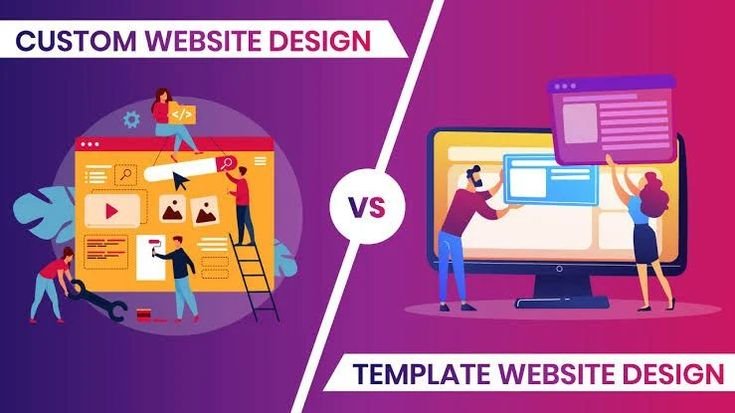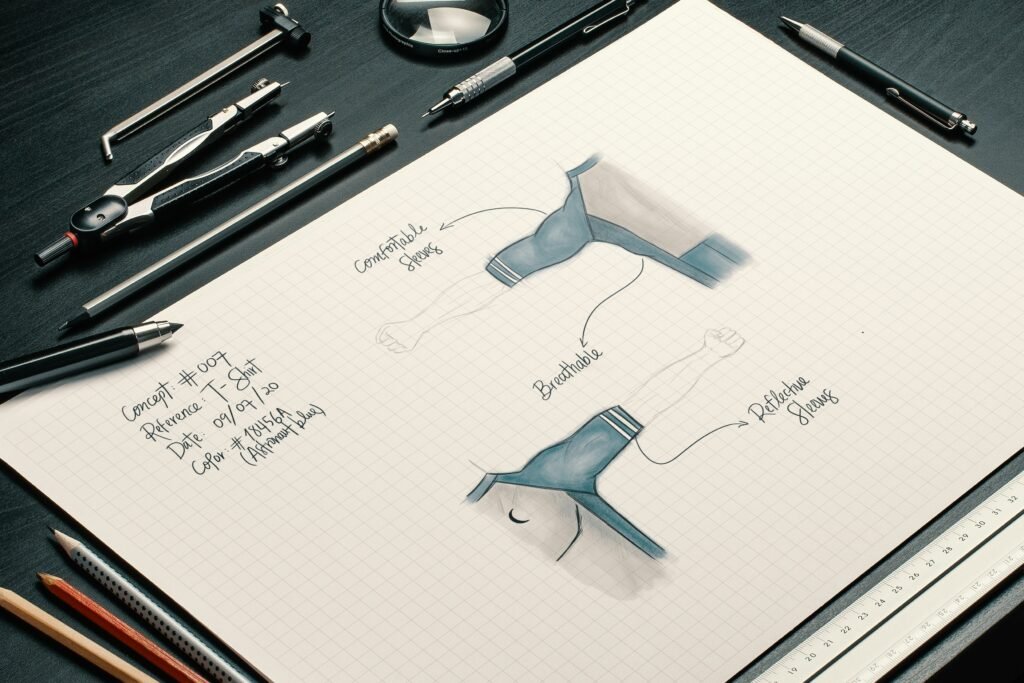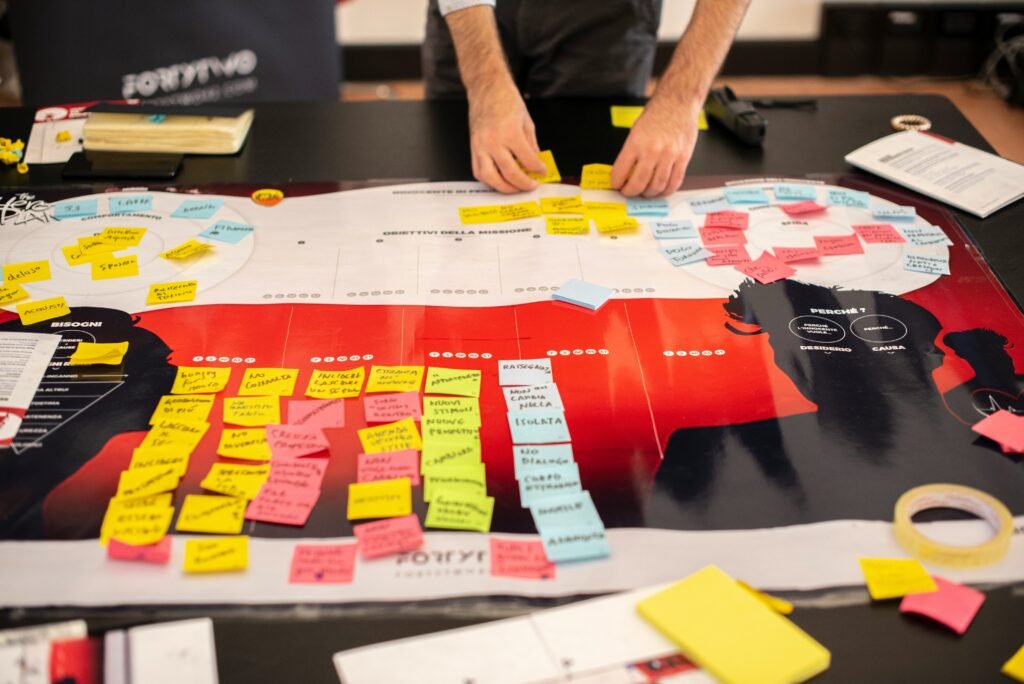Our Blogs

Custom vs. Template-Based Websites: What’s Right for Your Business?
In the digital age, your website is often your brand’s first impression. Whether you’re a startup, SME, or an established enterprise, choosing the right website approach is a pivotal decision. One of the most common dilemmas businesses face is whether to go for a custom-built website or opt for a template-based design.
Each option has its advantages and the right choice depends on your goals, budget, and timeline. Let’s break down the key differences to help you make an informed decision.
What Is a Template-Based Website?
Template-based websites are built using pre-designed layouts offered by platforms like WordPress, Wix, Shopify, or Squarespace. These templates come with preset structures, styles, and features that can be slightly customized using drag-and-drop editors.
- Advantages of Template-Based Websites
- Cost-Effective: Templates are typically budget-friendly, with lower upfront costs.
- Quick to Launch: You can have your site up and running in a matter of days.
- User-Friendly: No coding knowledge required great for beginners or DIY entrepreneurs.
- Variety of Designs: Hundreds of templates are available, covering most industries.
Limitations
Limited Customization: You’re confined to the template’s structure and features.
Generic Look: Your site may look similar to thousands of others using the same template.
Scalability Issues: As your business grows, templates may not support complex features or integrations.
Performance Constraints: Many templates include bloated code or plugins that can slow down your site. - What Is a Custom Website?
- A custom website is built from scratch by professional web developers and designers to match your specific brand identity, functionality, and business goals. Platforms used include HTML/CSS/JS, React, Laravel, or custom WordPress themes.
- Advantages of Custom Websites
- Tailored to Your Brand: Every element from layout to functionality is aligned with your brand vision.
- Scalable and Flexible: Easily adapt to growth, add features, and integrate with third-party tools or databases.
- Optimized Performance: Clean code, advanced SEO setups, and responsive design enhance speed and visibility.
- Unique Experience: Stand out in your industry with a fully personalized interface and user journey.
Challenges. - Higher Cost: Custom websites require a larger investment upfront.
- Longer Development Time: Building from scratch can take several weeks or months.
- Technical Dependency: You’ll need ongoing support from a developer or agency for updates and changes.
- When to Choose a Template-Based Website. You’re a startup or freelancer testing the waters.
You need a basic online presence, quickly.
Your budget is limited and you don’t require complex features.
You’re comfortable working with DIY builders. - When to Choose a Custom Website
You have a strong brand identity and specific functionality needs.
You plan to scale your website as your business grows.
User experience and conversion optimization are top priorities.
You want to stand out in a competitive market. - The iMate Recommendation
At iMate, we believe the decision should align with your long-term business vision. For quick launches or MVPs, a high-quality template site may suffice. But if you aim to create a powerful digital identity and build trust with your audience, a custom website is an investment worth making.
We offer both options crafted with care, backed by strategy, and supported by an expert team ready to evolve with your business.

How UI/UX Design Impacts Customer Retention and Conversions
In today’s digital-first world, having a website or app is no longer enough. To truly succeed, businesses must offer experiences that are not just functional but delightful. This is where UI (User Interface) and UX (User Experience) design come into play. When done right, UI/UX design can significantly boost customer retention, drive higher conversion rates, and turn casual visitors into loyal users. Let’s explore how and why great UI/UX design matters more than ever.
What is UI/UX Design?
Before diving into the impact, it’s important to understand the difference between UI and UX:
UI (User Interface): Refers to the visual layout of a digital product buttons, menus, typography, colors, and images.
UX (User Experience): Encompasses the overall experience a user has while interacting with your product, including ease of use, accessibility, navigation, and emotional response.
Think of UI as the look, and UX as the feel. Together, they create the total user journey
- The Business Impact of UI/UX Design
1. Higher Customer Retention
A smooth, intuitive, and enjoyable user experience encourages users to stay longer and return more frequently. Frustrated users abandon sites quickly often within seconds.
Good UX Means:
Easy navigation with minimal clicks
Fast-loading pages
Responsive design across devices
Clear call-to-actions (CTAs)
Visually pleasing layouts
Fact: According to Forrester Research, a well-designed UX can increase customer retention rates by up to 400%.
2. Increased Conversions
Design decisions directly influence user behavior. The placement of a button, the clarity of a headline, or the ease of checkout can make or break a sale.
UI/UX Elements That Drive Conversions:
Strategic CTA placement
Minimalistic and distraction-free design
Seamless onboarding process
Trust signals (like testimonials, security badges)
Predictable user flow
Example: Airbnb improved their conversion rate by redesigning their booking flow making it faster, cleaner, and mobile-friendly.
3. Enhanced Brand Perception
Your digital platform often serves as the first impression of your brand. A poorly designed interface sends the wrong message, while a polished and intuitive one instills confidence.
Clean UI = Professionalism
Thoughtful UX = Customer care
Over time, this builds brand loyalty, enhances credibility, and increases word-of-mouth referrals.
4. Lower Bounce Rates & Cart Abandonment
Poor design frustrates users. Confusing navigation, slow load times, or a cluttered interface can cause users to bounce or abandon their shopping carts hurting your bottom line.
With the right UX strategy, you reduce friction and guide users smoothly through the funnel from landing to purchase.
Real-World Example: How UI/UX Helped a Brand Scale
One of our clients at iMate, a growing e-commerce business, was struggling with high bounce rates and low conversions. After conducting a UX audit, we redesigned their site with:
Simplified product categories
Mobile-first responsive design
Optimized checkout process
Engaging visuals and microinteractions
Result? A 35% increase in conversions within two months and a 50% improvement in user engagement metrics.
UI/UX as a Competitive Advantage
In saturated markets, products and services can look similar—but experience sets you apart. Businesses that prioritize UI/UX design are seen as more reliable, professional, and trustworthy. They don’t just sell, they connect.
How iMate Can Help
At iMate, we design digital experiences that convert, retain, and inspire. Our UI/UX team combines data, psychology, and creativity to craft interfaces that are not just beautiful but effective. Whether it’s a mobile app, website, or software dashboard, we turn interactions into relationships.
SEO in 2025: What Businesses Need to Know Now
Search Engine Optimization (SEO) is no longer just about keywords and backlinks, it’s about creating real value for users in an increasingly intelligent digital landscape. As we step into 2025, search algorithms have become smarter, user behavior more complex, and the competition fiercer than ever.
Whether you’re a startup, an e-commerce store, or an enterprise brand, adapting to the evolving world of SEO is not optional, it’s essential. In this post, we’ll explore the major trends and actionable insights businesses must embrace to stay visible and competitive in 2025.
1. Search is Smarter: Embrace AI-Driven Algorithms
Search engines like Google are now using AI and machine learning to understand user intent far beyond basic queries. Google’s Search Generative Experience (SGE) and RankBrain are making context, semantics, and engagement critical for ranking.
✔ What You Should Do:
Focus on topic clusters rather than isolated keywords.
Create content that addresses intent like informational, navigational, or transactional.
Use AI tools for content planning, but should ensure human insight and originality.2. Mobile-First & Voice Search Optimization
In 2025, mobile traffic reaches for over 70% of web browsing and voice searches are rapidly growing through smart devices and virtual assistants.
✔ What You Should Do:
Ensure your site is fully responsive and optimized for all screen sizes.
Use natural language and long-tail keywords that mimic spoken queries.
Focus on local SEO, as voice searches often include location-based intent.3. Core Web Vitals & UX Signals Matter More Than Ever
Google continues to reward websites that provide a seamless user experience. Core Web Vitals like loading speed, interactivity, and visual stability, are critical ranking factors.
✔ What You Should Do:
Compress images, use lazy loading, and implement efficient caching.
Optimize JavaScript and remove unnecessary third-party scripts.
Ensure your design is clean, accessible, and UX-friendly.4. Content Quality > Content Quantity
Use of keyword stuffing and mass-produced blog posts are now not that effective. In 2025, the focus is on depth, relevance, and authority. AI tools are helpful, but search engines now value experience, expertise, authoritativeness, and trustworthiness (E-E-A-T).
✔ What You Should Do:
Publish original, well-researched content that solves real user problems.
Build topic authority over time by interlinking relevant articles.
Include author bios, sources, and structured data for credibility.5. Link Building Is About Relationships, Not Just Links
Backlinks still matter, but the game has changed. Google now emphasizes quality over quantity. A few backlinks from authoritative, relevant sites are worth more than dozens of spam links.
✔ What You Should Do:
Focus on digital PR, guest posting, and industry partnerships.
Create link-worthy content statistics, case studies, infographics, and guides.
Avoid manipulative link schemes or outdated tactics.6. Structured Data & Rich Snippets, Equals To More Visibility
Using schema markup helps search engines understand your content better and display it in richer formats, like featured snippets, FAQs, reviews, and more.
✔ What You Should Do:
Implement schema for articles, products, reviews, FAQs, and more.
Monitor your site’s rich results in Google Search Console.
Stay updated on new markup types as they’re introduced.7. Local & Multi-language SEO are Game Changers
As search becomes more localized and globalized at the same time, businesses that cater to specific regions or international audiences must set their SEO strategies.
✔ What You Should Do:
Optimize Google Business Profile and local directories.
Use hreflang tags and regional content for multi-language sites.
Level local keywords and region-specific search intent.8. Comprehensive SEO Integration Across Channels
In 2025, SEO works best when it’s integrated with your broader digital strategy which includes social media, email marketing, and paid ads. Search engines analyze brand signals from across the web.
✔ What You Should Do:
Transform written content into engaging multimedia formats like videos, reels, and social snippets.
Encourage social shares and user engagement to boost SEO.
Track multi-channel attribution to understand content performance.What SEO Success Looks Like in 2025
Pages that load in under 2 seconds
High engagement and low bounce rates
Featured in snippets, FAQs, and People Also Ask
Ranking for intent-based long-tail keywords
Strong presence across mobile, voice, and local searchFinal Thoughts: Adapt or Be Invisible
SEO in 2025 is not about tricking search engines but it’s about serving users better than anyone else. Businesses that prioritize value-driven content, technical performance, and a great user experience will be the ones who rise above the noise.
At iMate, we specialize in SEO strategies that are data-backed, future-focused, and conversion-driven. Whether you’re looking to climb the SERPs or stay ahead of the curve, we’re here to help you make the smartest move.Want to Future-Proof Your SEO Strategy?
Let’s talk. Reach out to iMate for a personalized SEO audit and strategy session. Your digital growth starts here.

Case Studies: How iMate Helped Businesses Grow Digitally
In today’s highly-connected world,
digital transformation is no longer a trend, it’s a survival strategy. At iMate, we don’t just give IT services, we build digital growth system. From start-ups to established businesses, we’ve helped a range of businesses redefine their online presence, streamline operations, and drive measurable results.
Here’s a look at how iMate helped real businesses scale in the digital landscape, turning challenges into success stories.
Case Study 1: E-Commerce Transformation for a Fashion Retail Brand
Client: Local fashion retailer with offline stores
Problem: Lacked an online presence and was struggling with declining physical traffic
-
Our Solution:
Designed and developed a fully responsive e-commerce website
Integrated inventory management and payment methods
Ran targeted social media and Google Ads campaigns
Implemented SEO strategy to build organic visibility
Results:
Rapid increase in monthly sales within 4 months
40% of revenue shifted to online channels
Grew from local sales to international shippingCase Study 2: Website Redesign for a Legal Consultancy Firm
Client: Mid-sized law firm
Problem: Outdated website, poor user experience, and low search engine visibility
Our Solution:
Conducted UI/UX audit and redesigned the site for clarity and trust
Implemented mobile responsiveness and fast-loading base
Optimized for local SEO and added schema markup
Created a content strategy including legal blogs and FAQs
Results:
Significant increase in user engagement
Ranking High on Google for major local keywords
Improved lead generation through contact forms and CTAsCase Study 3: Full-Suite IT Services for a SaaS Startup
Client: Early-stage software company
Problem: Needed end-to-end support for branding, product launch, and digital presence
Our Solution:
Designed brand identity, logo, and UX-driven web app interface
Developed a marketing website and custom dashboards
Implemented SEO, email marketing, and PPC strategy
Provided ongoing tech support and scalability planning
Results:
Product launch in record time (6 weeks)
Achieved triple digit signups in the first quarter
Established as a credible name in their niche via digital PRCase Study 4: Digital Upgrade for a Real Estate Company
Client: Property consultancy
Problem: Low online visibility, no lead automation, and a busy website
Our Solution:
Built a modern, lead-optimized website with listings integration
Introduced CRM integration and automatic inquiry handling
Ran highly-local ad campaigns targeting property buyers
Results:
4x increase in qualified leads
Reduced lead response time by 80%
Built a repeat customer base through remarketing and email flowsWhat These Case Studies Reveal
At iMate, we take pride in offering customized, scalable, and impactful digital solutions. Our collaborative approach, technical depth, and focus on measurable results have consistently leads clients across industries to scale efficiently in the digital age.
Whether you’re an emerging business or a growing brand, we have the expertise to help you:
Modernize your digital infrastructure
Reach your target audience effectively
Convert traffic into loyal customersReady to Transform Your Business?
Let us build your next digital success story. Get in touch with iMate for a free consultation and see how we can make your growth the smartest move.

Signs Your Business Needs a Tech Upgrade
In the fast-paced digital world, technology plays a critical role in leading business success. As your company grows, the need to stay competitive with modern tools and systems is necessary. However, knowing when it’s time to upgrade your technology can be tricky. Here are five clear signs that your business is in need of a tech upgrade.
1. Your Systems Are Outdated and Slow
The Sign:
Your software and systems are slowed, causing delays in operations and frustrating your team. Tasks that should take minutes can take hours, and the overall workflow feels slow and inefficient.
Why It Matters:
Outdated systems can significantly effect productivity. With slower performance, employees spend more time waiting on systems, which negatively impacts both morale and customer satisfaction. An upgrade to modern, high-performance systems will improve efficiency and ensure your team is working at its best.
2. Your Software Doesn’t Connect with Other Tools
The Sign:
You use multiple software tools, but they don’t talk to each other. This leads to manual data entry, double work, and the risk of human error. Information gets stuck in disconnected team, and key insights are often missed.
Why It Matters:
In today’s world, connection is the key. A tech upgrade can provide you with seamless solutions that connect all your tools, streamlining data flow, enhancing communication, and enabling real-time collaboration. It saves time, reduces errors, and enhances data-based decision-making.3. You’re Struggling with Cybersecurity Threats
The Sign:
Your business is regularly experiencing data breaches, cyber threats, or security weakness. You may also notice a lack of security precautions, like firewalls or encryption, to safeguard your sensitive data.
Why It Matters:
Cyber threats are more sophisticated than ever. If your current tech infrastructure is outdated or lacks proper security protocols, your business is unprotected to attacks. Upgrading your security systems will help protect your data, customer trust, and the longevity of your business.4. Your Team Is Using Multiple Scattered Platforms
The Sign:
Different departments use different platforms, and they don’t communicate with each other. You may have one team using one CRM, another team using a different project management tool, and your sales team relying on an outdated system for tracking purpose.
Why It Matters:
A disconnected workflow creates inefficiencies, limits collaboration, and ultimately reduces overall productivity. A unified solution or platform can streamline operations, making it easier to track projects, sales, and communications, and improving cross-functional collaboration.5. You’re Losing Customers Due to Poor User Experience
The Sign:
Customers are constantly complaining about your website or app. Navigation is difficult, your checkout process is slow, or they’re facing issues that lead to frustration. You may notice increasing bounce rates or a decline in user engagement.
Why It Matters:
User experience (UX) is critical in retaining customers. If your website or application isn’t optimized, potential customers will find your competitors. Upgrading your tech from a faster website to a smoother app experience can lead to improved customer satisfaction, higher conversion rates, and greater retention.Why You Should Act Now
Technology evolves rapidly, and businesses that fail to keep up risk falling behind the competition. If you’re noticing any of these signs, it’s time to take action and consider a tech upgrade. Whether it’s modernizing your systems, enhancing security, or improving user experience, an investment in technology will pay off in the long run.Get Ahead with iMate’s Tech Solutions
At iMate, we specialize in providing tailored tech solutions to businesses like yours. Whether it’s upgrading your infrastructure, enhancing security, or improving integration, we’re here to help you take your business to the next level.
Contact us today to discuss how we can support your digital transformation.
Join Our Newsletter
Hot updates. Cool perks. Straight to you.
Copyright © 2025.I Mate All rights reserved.




